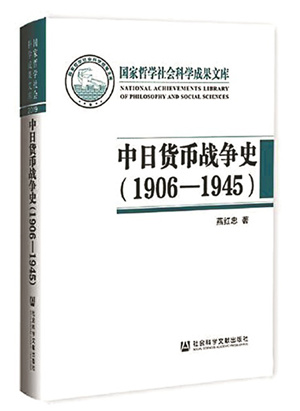
. > WHAT'S NEW > BOOKS
A study of China-Japan currency war (1906–45)
Author : ZHU YINGUI Source : Chinese Social Sciences Today 2022-03-30

A History of China-Japan Currency War (1906–1945)
A History of China-Japan Currency War (1906–1945), written by Yan Hongzhong, chair professor with Shanghai University of Finance and Economics, comprehensively discusses Japan’s colonial infiltration of China, expansion of trade with China, seizing of economic rights and interests, currency system reform, and direct economic and financial resource plundering in modern times. Meanwhile, it shows confrontation forms and content on the Chinese side.
After the Russo-Japanese War (1904–05), the emerging Japanese militarist government made aggressive attempts to turn China into a colony. Starting in northeast China, it gradually gained control over currency and finance in this area. It launched the outrageous September 18th Incident in 1931 and supported the puppet “Manchukuo” regime as a proxy to control the whole of northeast China. Further, the aggressive reach stretched to inside Shanhaiguan Pass, and in 1937 a comprehensive invasion of China started, in a vain attempt to turn China into a Japanese colony. After the defeat in 1945, they finally withdrew from China.
In the whole process, Japan tried to control China’s finance through a currency war to serve the purpose of the Japanese militarist government, constituting an important component of its aggression policy. In each stage of this process, Japan adopted all sorts of unscrupulous means and plots, and the resistance and counterattack struggle of the Chinese people from all walks of life were as impressive as the military counterattacks on the battlefield.
In the standard sense, currency war refers to the struggle between capitalist countries or groups in the currency field competing for world market and financial hegemony. However, the currency war between Japan and China in modern times is not exactly equivalent to the general definition, but an invasion and anti-invasion confrontation and struggle in the currency and financial field under a specific political and economic background.
This struggle went through four stages. Specifically, the conflict of trade and currency dominance in northeast China in the late Qing Dynasty (1644–1911); after the late Qing Dynasty and before the 1930s, checks and balance around such issues as the exchange of fengpiao [paper money issued and widely circulated in the northeast region between 1905 and 1931], currency market competition, and loans for reforming the currency system; in the 1930s, mutual war over the unification of the currency system and the reform of the fabi [China’s currency between 1935 and 1948]; confrontation around the destruction or mobilization of the “economic force against Japanese aggression” during the nationwide war of resistance against Japanese aggression. Although these four stages have different forms and contents, they constitute a long-term and continuous historical process.
Zhu Yingui is a professor from the Department of History at Fudan University.
Ye Shengtao made Chinese fairy tales from a wilderness
Ye Shengtao (1894–1988) created the first collection of fairy tales in the history of Chinese children’s literature...
-
How northern ethnicities integrated into Chinese nation
2023-09-18
-
Mogao caves
2023-09-12
-
Mogao Grottoes as ‘a place of pilgrimage’
2023-09-12
-
Time-honored architectural traditions in China
2023-08-29
-
Disentangling the civilizational evolution of China
2023-08-28
-
AI ethics in science fiction
2023-08-23













 2011-2013 by www.cssn.cn. All Rights Reserved
2011-2013 by www.cssn.cn. All Rights Reserved